Machairodontinae
| Machairodontines Temporal range: Miocene - Holocene, 23–0.01 Ma | |
|---|---|
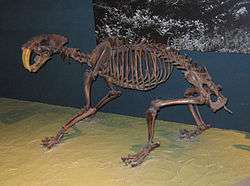 | |
| Mounted fossil skeleton of a Smilodon fatalis, National Museum of Natural History | |
| Scientific classification | |
| Kingdom: | Animalia |
| Phylum: | Chordata |
| Clade: | Synapsida |
| Class: | Mammalia |
| Order: | Carnivora |
| Family: | Felidae |
| Subfamily: | †Machairodontinae Gill, 1872 |
| Subgroups | |
Machairodontinae is an extinct subfamily of carnivoran mammals of the family Felidae (true cats). They were found in Asia, Africa, North America, South America, and Europe from the Miocene to Pleistocene living from about 23 million until about 11,000 years ago.[1]
The Machairodontinae contain many of the extinct predators commonly known as "saber-toothed cats", including the famed genus Smilodon, as well as other cats with only minor increases in the size and length of their maxillary canines. The name means "dagger-tooth", from Greek μάχαιρα (machaira), dagger. Sometimes, other carnivorous mammals with elongated teeth are also called saber-toothed cats, although they do not belong to the felids. Besides the machairodonts, saber-toothed predators also arose in Nimravidae, Barbourofelidae, Machaeroidinae, Hyaenodontida and even in two groups of metatherians (Thylacosmilidae sparassodonts and deltatheroideans).[2]
Evolution
Family Felidae
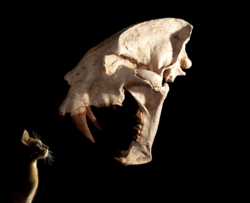
The Machairodontinae originated in the early or middle Miocene of Africa. The early felid Pseudaelurus quadridentatus showed a trend towards elongated upper canines, and is believed to be at the base of the machairodontine evolution.[3] The earliest known machairodont genus is the middle Miocene Miomachairodus from Africa and Turkey.[4] Until the late Miocene, machairodontines co-existed at several places together with barbourofelids, archaic large carnivores that also bore long sabre-teeth.[2]
Traditionally, three different tribes of machairodontines were recognized, the Smilodontini with typical dirk-toothed forms, such as Megantereon and Smilodon, the Machairodontini or Homotherini with scimitar-toothed cats, such as Machairodus or Homotherium, and the Metailurini, containing genera such as Dinofelis and Metailurus. However, some have recently regrouped the Metailurini within the other felid subfamily, the Felinae, along with all modern cats.[2] The last machairodontine genera, Smilodon and Homotherium, did not disappear until late in the Pleistocene, roughly 10,000 years ago in the Americas.
The name 'saber-toothed tigers' is misleading. Machairodonts were not even in the same subfamily as tigers, there is no evidence that they had tiger-like coat patterns, and this broad group of animals certainly did not all live or hunt in the same manner as the modern tiger. DNA analysis published in 2005 confirmed and clarified cladistic analysis in showing that the Machairodontinae diverged early from the ancestors of modern cats and are not closely related to any living feline species.[2]
Saber-tooths also coexisted in many places with conical-toothed cats. In Africa and Eurasia, sabertooth cats competed with several pantherines and cheetahs until the early or middle Pleistocene. Homotherium survived in northern Europe even until the late Pleistocene. In the Americas, they coexisted with the cougar, American lion, American cheetah, and jaguar until the late Pleistocene. Saber-toothed and conical-toothed cats competed with each other for food resources, until the last of the former became extinct. All recent felids have more or less conical-shaped upper canines.
Evolutionary history and origin of phenotype
Phylogeny of Machairodontines with the three out-groups, Proailurus, Pseudaelurus, and all modern, conical-toothed cats, with a brief description of each genus:[5][6][7][8]
| FELIDAE |
| |||||||||||||||||||||||||||||||||||||||||||||||||||||||||||||||||||||||||||||||||||||||||||||||||||||||||||||||
| |
Classification
- Family Felidae
- Subfamily Machairodontinae
- Tribe Homotherini
- Genus Amphimachairodus[14]
- Genus Lokotunjailurus
- Genus Nimravides[15]
- Genus Homotherium
- Genus Xenosmilus
- Tribe Metailurini
- Genus Adelphailurus
- Genus Dinofelis
- Genus Pontosmilus
- Genus Stenailurus
- Genus Metailurus
- Genus Yoshi[16]
- Tribe Smilodontini
- Genus Megantereon
- Genus Paramachairodus
- Genus Promegantereon[17]
- Genus Rhizosmilodon
- Genus Smilodon
- Tribe Machairodontini
- Genus Hemimachairodus
- Genus Miomachairodus
- Genus Machairodus
- Tribe Homotherini
- Subfamily Machairodontinae
Until the recent discovery of the Late Miocene fossil depository known as Batallones-1 in the 1990s, specimens of Smilodontini and Homotheriini ancestors were rare and fragmentary, so the evolutionary history of the saber-toothed phenotype, a phenotype affecting craniomandibular, cervical forelimb and forelimb anatomy, was largely unknown.[18][19] Prior to the excavation of Batallones-1, the predominating hypothesis was that the highly derived saber-toothed phenotype arose rapidly through pleiotropic evolution.[20] Batollnes-1 unearthed new specimens of Promegantereon ogygia, a Smilodontini ancestor, and Machairodus aphanistus, a Homotheriini ancestor, shedding light on evolutionary history.[18][19] (Though the Smilodontini ancestor was originally assigned to the genus Paramachairodus, it was later revised to the genus Promegantereon).[21] The leopard-sized P. ogygia (living 9.0 Ma) inhabited Spain (and perhaps additional territory), and its most studied descendants, the members of the tiger-sized genus Smilodon, lived up to 10,000 years ago in the Americas.[22] The lion-sized M. aphanistus (living 15.0 Ma) roamed Eurasia, as did its most studied descendants, members of the lion-sized genus Homotherium (living 3.0-5.0 Ma).
The current hypothesis for the evolution of the saber-toothed phenotype, made possible by Batollnes-1, is that this phenotype arose gradually over time through mosaic evolution.[18][19] Although the exact cause is uncertain, current findings have supported the hypothesis that a need for the rapid killing of prey was the principle pressure driving the development of the phenotype over evolutionary time. As indicated by high instances of broken teeth, the biotic environment of saber-toothed cats was one marked by intense competition.[23][24]
Broken teeth indicate the frequency at which teeth contact bone. Increased teeth-bone contact suggests either increased consumption of carcasses, rapid consumption of prey, or increased aggression over kills – all three of which point to decreased prey availability, heightening competition between predators. Such a competitive environment would favor the faster killing of prey, because if prey is taken away before consumption (such as by out-competing) the energetic cost of capturing that prey is not reimbursed, and, if this occurs often enough in the lifetime of a predator, death by exhaustion or starvation would result. The earliest adaptations improving the speed at which prey was killed are present in the skull and mandible of P. ogygia and of M. aphanistus,[18][19] and in the cervical vertebrae[19] and forelimb[25] of P. ogygia. They provide further morphological evidence for the importance of speed in the evolution of the saber-toothed phenotype.[25]
Skeleton
Skull
The most studied section of the machairodont group is the skull, and specifically the teeth. With a large range of genera, good fossil representation, comparable modern relatives, diversity within the group, and a good understanding of the ecosystems inhabited, the machairodont subfamily provides one of the best means of research for the analysis of hypercarnivores, specialization, and the relationships between predator and prey.[26]
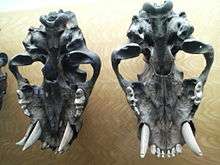
Machairodonts are divided into two types: dirk-toothed and scimitar-toothed. Dirk-toothed cats had elongated, narrow upper canines and generally had stocky bodies. Scimitar-toothed cats had broader and shorter upper canines and a typically lithe body form with longer legs. The longer-toothed cats often had a bony flange that extended from their lower mandible. However, one genus, Xenosmilus, known only from two fairly complete fossils, broke this mould; possessing both the stout, heavy limbs associated with dirk-toothed cats, and the stout canines of a scimitar-toothed cat.
Carnivores reduced the number of their teeth as they specialized in eating meat instead of grinding plant or insect matter. Cats have the fewest number of teeth of any carnivore group, and machairodonts reduce the number even further. Most machairodonts retain six incisors, two canines, and six premolars in each jaw, with two molars in the upper jaw only. Some genera, such as Smilodon, bear only eight premolars with one fewer on the mandible, leaving only four large premolars on the mandible along with two stunted canines and six stout incisors. The canines are curved back smoothly, and serrations are present, but are minor and wear away with age, leaving most middle-aged machairodonts (at about four or five) with no serrations. Hints in the bones such as these help paleontologists to estimate the age of an individual for population studies of an animal long extinct.
Longer canines necessitate a larger gape. A lion with a gape of 95° could not bear canines that are nine inches long because they would not be able to have a gap between the lower and upper canines larger than an inch or so, not enough to use for killing. Machairodonts, along with the other groups of animals that acquired similar teeth by convergent evolution, needed a way to change their skulls to accommodate the canines in several ways.
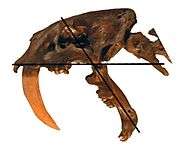
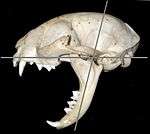
The main inhibitors of a large gape for mammals are the temporalis and masseter muscles at the back of the jaw. These muscles have the capacity to be powerful and undergo a great degree of modification for ranging bite forces, but are not very elastic due to their thickness, placement, and strength. To open the mouth wider, these species needed to make the muscles smaller and change their shape. The first step in this was to reduce the coronoid process. The masseter, and especially the temporalis, muscles insert on this jutting strip of bone, so reduction of this process meant the reduction of the muscles. Less mass for each muscle allowed greater elasticity and less resistance to a wide gape. Changing the shape of the temporalis muscle in this respect created a greater distance between the origin and insertion, so that the muscle became longer and more compact, which is generally a more suitable format for this type of stretching. This reduction led to a weaker bite.
The skulls of machairodonts suggests another change in the shape of the temporalis muscle. The main constraint to opening the jaws is that the temporalis muscle will tear if it is stretched past a critical degree around the glenoid process when the mouth is opened. In modern felids, the occipital bone extends backward, but the temporalis muscles that attach to this surface are strained when opening the jaw wide as the muscle is wrapped around the glenoid process. To reduce the stretch of the temporalis muscle around the immovable process, machairodonts evolved a skull with a more vertical occipital bone. The domestic cat has a gape of 80°, while a lion has a gape of 91°. In Smilodon, the gape is 128°, and the angle between the ramus of the mandible and the occipital bone is 100°. This angle is the major limiting factor of the gape, and reducing the angle of the occipital bone relative to the palate of the mouth, as seen in Smilodon, allowed the gape to increase further. Had the occipital bone not been stretched towards the palate, and closer to perpendicular, the gape would theoretically be less, at roughly 113°.
The skulls of many sabre-tooth predators, including machairodonts, are tall from top to bottom and short from front to back. The zygomatic arches are compressed, and the portion of the skull bearing facial features, such as eyes, is higher, while the muzzle is shorter.[27] These changes help to compensate for an increased gape.[28] Machairodonts also had reduced bottom canines, maintaining the distance between those in the upper and lower jaws.




Post-cranial skeleton
The dirk-toothed machairodonts, including Smilodon, Megantereon, and Paramachairodus, are defined by sturdiness and strength with the most primitive (Paramachairodus) being smaller and more lithe than the more advanced Smilodon; the intermediate Megantereon falls in between. They were not stamina runners with short tarsi and metatarsi and heavy bodies. When compared with the modern lion, their ribcages were barrel-like with narrow anterior ends and expanded posterior ends. Their scapulae were very well developed, especially in Smilodon, to allow for a larger surface area of attachment for massive shoulder and triceps muscles. The cervical vertebrae are very sturdy, and the attachments for muscles were powerful and strong. The lumbar section of the vertebral column was shortened. The tails were, from most primitive to most advanced, growing shorter and shorter, resulting in the bobcat-like tail of Smilodon. When viewing only postcranial remains, they are more similar in structure to modern bears than to modern cats.[29]
The scimitar-toothed machairodonts, including Machairodus, Miomachairodus, Homotherium, Adelphailurus, Dinofelis, Metailurus, Pontosmilus, Therailurus, Lokotunjailurus, and technically Xenosmilus, are a much more diverse group and most machairodonts fall into this less specialized type. The canines of this larger group are significantly shorter and generally stouter. Because of the diversity of the genera, it is difficult to illustrate a specific type. Homotherium was once thought to be plantigrade, but was proven to be digitigrade.[30] This group is generally much leaner and smaller on average, though Machairodus was one of the largest, if not the largest, of all machairodonts. Some display high degrees of sexual dimorphism, unlike the dirk-toothed cats (Machairodus). Homotherium bore a sloped back that might have made it excellent at running long distances, similar to the living spotted hyena. They usually had longer legs and a more lithe form. They had more teeth than the average dirk-toothed machairodont, with six premolars on the mandible. Machairodus appears to have been an excellent jumper. When viewing only postcranial remains of similar-toothed machairodonts, their forms were comparatively similar to modern pantherines (genera Panthera, Neofelis, and Uncia).[29]
Derived anatomy and diet

Bite strength
The jaws of machairodonts, especially more derived species with longer canines, such as Smilodon and Megantereon, are unusually weak. Digital reconstructions of the skulls of lions and of Smilodon show that the latter would have fared poorly with the stresses of holding onto struggling prey.[31] The main issue was the stresses suffered by the mandible: a strong force threatened to break the jaw as pressure was placed on its weakest points.
Smilodon would have had one-third the bite force of a lion, had it used only its jaw muscles. However, the neck muscles that connected to the back of the skull were stronger and depressed the head, forcing the skull down. When the jaw was hyper-extended, the jaw muscles could not contract, but the neck muscles pressed the head down, forcing the canines into whatever resisted them. When the mouth was closed far enough, the jaw muscles could raise the mandible by some margin.[31]
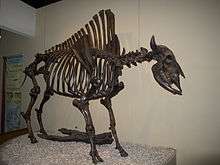
Diet
On occasion, the bone of a fossilised predator is preserved well enough to retain recognizable proteins that belong to the species it consumed when alive.[32][33] Stable isotope analysis of these proteins has shown that Smilodon preyed mainly on bison and horses, and occasionally ground sloths and mammoths, while Homotherium ate almost exclusively mammoths.
The face
American paleontologist George Miller set forth a set of features not previously thought of in the soft tissues of machairodonts, specifically Smilodon.[26]
The first change he suggested in the appearance of machairodonts were lower ears, or rather the illusion of lower ears due to the higher sagittal crest. This claim has been generally discarded due to its unique nature: no other modern carnivores have these low-set ears for this reason, and Antón, García-Perea and Turner (1998) point out that the positioning of the ears is always similar in modern felids, the group’s closest living relatives, even in individuals that have crests comparable in size to those of sabretooth cats.[34] The positioning of the pinnae, or outer ears, along with fur color, are dependent on the individual doing the reconstruction. Large or small, pointed or rounded, high or low, fossils do not record these characteristics, leaving them open to interpretation.
Miller also suggested a pug-like nose. Aside from the pug and similar dogs, no modern carnivore exhibits a pug nose. The relatively low distribution of the pug nose has resulted in it being generally ignored. Miller's rationale is based on the retraction of Smilodon nasal bones. Criticism of Miller's theory compares the nasal bones of lions and tigers. Lions, when compared to tigers, also have strongly retracted nasal bones, but a lion's rhinarium, or external nose, is no more retracted than the tiger's. Thus, the pug nose of Smilodon proposed by Miller has little evidence in the physical structures of comparable animals. According to Antón, García-Perea and Turner (1998), the nostrils of living felids always extend to a similar position, independently of the length of the nasal bones, which in Smilodon falls within the range observed in modern species.[35]
The third idea proposed is the elongation of the lips by 50%. While his other hypotheses have been largely discarded, the last is used significantly in modern depictions. Miller argues that longer lips allows the greater elasticity needed for biting prey with a wider gape. Although this argument has been disputed within the scientific community, it remains supported nevertheless by artists. Scientific criticism points out that the lips of modern cats, especially larger species, display incredible elasticity and the usual lip length would stretch suitably, despite the larger degree of opening,[36] and that in living carnivores the lip line is always anterior to the masseter muscle, which in Smilodon was located just behind the carnassials.[37] Regardless, reconstructions of Smilodon, Machairodus, and other species are shown with long lips, often resembling the jowls of large dogs.
Vocalizations
Comparisons of the hyoid bones of Smilodon and lions show that the former, and possibly other machairodonts, could potentially have roared like their modern relatives.[38][39]
Social behavior
Smilodon
A 2009 study compared the ratios of social and solitary carnivores in reserves in South Africa and Tanzania with those of fossils in the La Brea tar pits, a well-known fossil bed from the Pleistocene,[40] and how they responded to recorded sounds of dying prey, to infer whether Smilodon was social or not. At one time, the La Brea tar pits consisted of deep tar in which animals became trapped. As they died, their calls attracted predators, which in turn also became caught. It is considered the best Pleistocene fossil bed in North America for the number of animals caught and preserved in the tar, and may be similar to the situation created in the study. The assumption was that solitary carnivores would not approach the sources of such sounds, because of the danger of confrontation with other predators. Social carnivores, such as lions, have few other predators to fear, and will readily attend these calls. The study concluded that this latter situation most closely fit the ratio of animals found at the La Brea tar pits, and therefore that Smilodon was most likely social.[40]
Homotherium
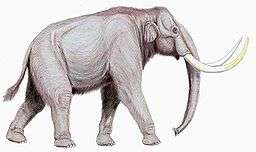
At Friesenhahn Cave, Texas, the remains of almost 400 juvenile mammoths were discovered along with skeletons of Homotherium. Homotherium groups have been suggested to have specialized in hunting young mammoths, and to have dragged the kills into secluded caves to eat out of the open. They also retained excellent nocturnal vision, and hunting at night in the arctic regions would probably have been their prime hunting method.[41]
A subspecies of lion found in southern Africa, especially Botswana, rivals the size of tigers. In Savute, Botswana, a single pride of these lions, including over 30 individuals, has specialized in hunting large prey animals such as giraffes, Cape buffalo, and elephants. Such attacks almost always take place at night when the elephant's vision is hindered.[42] They often begin eating from the rear up, and, in a fashion very different from the killing mode of other cats, they will often begin to devour the elephant alive until it dies of blood loss.[43] Their progress from hunting calves to subadults to successfully hunting fully grown adults has been observed in a relatively short time. Another pride in the Linyanti area of Botswana has specialized in hunting hippopotamus.
If the modern lion is capable of, in large numbers, killing weakened adult and healthy subadult elephants, similar sized Homotherium likely could have managed the same feat with juvenile mammoths. This is supported by isotopic analysis. But the idea that a cat, even one of very large size and possibly social, was able to cooperatively 'drag' a 400-pound mammoth calf any real distance into a cave without damaging its teeth has aroused great criticism. Its sloped back and powerful lumbar section of its vertebrae suggested a bear-like build, so it might have been capable of pulling weights, but breaking canines, a fate suffered by Machairodus and Smilodon with some frequency, is not seen in Homotherium. The question still remains as to whether scavengers dragged these bones to the cave and had nothing to do with the presence of Homotherium remains, or whether the cats cooperatively dragged these kills somehow.
Paleopathology

Machairodus is another genus with few fossil records to suggest a social nature, but canines on these species are broken more often than others and show signs of extensive healing afterward. A male Amphimachairodus giganteus from China housed by the Babiarz Institute of Paleontological Studies is an older individual with a broken canine, worn from usage after the break. However, the individual died of a severe nasal infection, an injury that a social predator would have had a better chance of healing, so the skull can be interpreted in different ways.[44] The adult canine teeth of juvenile Machairodus took an exceptionally long time to erupt and be used, so until then, it was completely dependent on the care of its parents. The difficult feat of caring for helpless offspring has been suggested as a driving factor for human monogamy and social structures in part as human brains grew larger and, to cope, human infants were born slightly premature and underdeveloped. Other species that have especially helpless offspring, such as elephants, group for protection, but others, such as most species of whale, do not. It was likely advantageous for Machairodus to group together, but it is difficult to tell whether the mother alone could comfortably support her toothless cubs until they were three or four years old.
In another example of paleopathology supporting the social hypothesis, a large number of Smilodon fossils from the La Brea tar pits feature hunting injuries. In addition to injuries resulting from strain while hunting, the more severe injuries strongly suggest a social nature. Animals may have been crippled long after the injury healed, suffering swollen ankles, prominent limps, and limited mobility that persisted for years.[38] One such case displays a subadult suffering a shattered pelvis that healed. The specimen would barely have been able to use the damaged limb and would have limped slowly, favoring the other three legs, completely unable to hunt on its own.[45] If a solitary predator would have been able to survive such a severe injury, it would have been a very rare occasion. It is far more likely that such an animal would have been unable to move from a single spot on the ground for several months and might have only survived by being brought food or dragging itself towards kills made by relatives.
Rebuttals to the social hypothesis
The question of sociality is still controversial. Strong support for the traditional concept of a solitary Smilodon is found in its brain. Most social predators, including humans, grey wolves, and lions, have brains that are slightly larger than those of their loner relatives. Smilodon had a relatively small brain, suggesting less ability for complex cooperative behaviors, such as hunting in groups.[46] The high numbers of Smilodon in the tar pits is often dismissed as evidence for a social nature because the golden eagle, a species still extant, is solitary and yet is found in the pits in similar numbers. The social grey wolf and coyote lived in the region, but their fossils in the pits are rare.
The broken bones still seem to support sociality, however, the best explanation for a solitary animal healing from serious wounds is that cats build up metabolic reserves that can be used in times of need. The cheetah is often viewed as a poor example because it is a specialized species with a more fragile physique than other cats. Larger, more sturdily built cat species, such as lions and leopards, have been observed to recover from severe injuries, such as broken jaws and torn muscles.
Purpose of the canines
A number of explanations have been proposed for the unusually long canine teeth of machairodontines and other saber-tooth cats.
Stabbing
This idea describes the use of the canines for stabbing: the machairodont would grapple with an animal, open its mouth, retract from the animal, and swing its head down with enough force to puncture the animal's skin and flesh. It was once suggested that the teeth of saber-toothed cats were used in the manner of a hand wielding a knife.[26] The canines seemed, initially, as tools of great power and devastating ability, used for crushing vertebrae, or for tearing open armored animals such as glyptodonts. Many early scientific papers on the subject of machairodonts displayed them killing prey in such a manner. It was widely accepted by the public and became a mainstream idea, depicted in artwork and films.
However, teeth are not metal blades, they are made of unsupported enamel, and would have been easily broken against hard material such as bone. It has also been argued that the mandible would have been an impediment to effective stabbing.[26] For such reasons, this concept has been rejected by the scientific community.
Sexual characteristic
This alternative suggestion poses a debate of whether or not the teeth were actually used for killing or whether they could be used for sexual selection. Several traits, such as a lion's mane, are driven by competition between males and females' ability to choose their mates from those which are healthy and possible mates based on their own criteria. How the criteria for each species is selected is not well known, whether it produces females that prefer males with sexual ornaments, or otherwise cumbersome body additions.
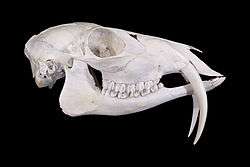
In machairodonts, this selection for long canines could be analogous to the antlers of deer or the mane of lions, in that machairodonts (and possibly other saber-toothed predators) were driven to develop these characteristics through sexual selection, where they would be used for courting, sexual display, and social status. Machairodonts were perhaps another species driven to adopting odd traits in a mating game, and that their canines had no other functional purpose. Their canines are already well established as relatively fragile, and their jaw muscles not strong, so any actual functional purpose seems uncertain.[47]
Several significant debates to this theory are made. In most species where such a nonfunctional trait is adopted to enhance sexual attraction, only one gender, typically males, display the feature. In all machairodont species, both males and females have these canines and, with only minor exceptions as in Machairodus, are shaped similarly. Most species that display a high degree of sexually driven characteristics also display more than one physical difference: size usually varies in such species. Male deer not only have antlers, they are also typically larger. Male lions not only have manes, but they also are larger. Male American kestrels are not only more brightly colored than their female counterparts, but also they are smaller.[48] Male and female machairodonts appear to be the same size. To adopt these traits for this purpose alone, a machairodont would be severely impaired in eating and general function. The changes to allow their jaws to expand, other teeth to adjust in size and number, and skull morphology to alter significantly simply to accommodate this feature seem extreme and unrealistic to many.[26]
Scavenging
One suggestion is that most machairodonts were scavengers. This leaves the canines not functional for the most part, and is often coupled with the hypothesis of sexual selection. Many modern carnivores scavenge to a greater or lesser degree. A strong sense of smell and good hearing could have helped find carcasses or steal the kills of other predators, such as dire wolves or short-faced bears, and sprinting would not have been needed, as is seen in the stocky conformation of most machairodonts.[26]
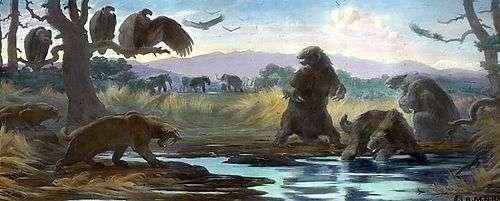
Many modern cats show this mixture of traits. Lions are able-bodied hunters, but will steal when they are given the opportunity. Tigers and cougars bury their kills and return later to keep eating, even days later. All cats prefer killing the sick or injured, and there is a fine line between an animal so sick it cannot move and a dead animal. The abundance of Smilodon skeletons in the La Brea tar pits in California supports the hypothesis, as well. The animals caught in the pits would have been dying or dead, the kind of meal a true hypercarnivore, such as a modern cheetah, would pass up. This hypothesis is the oldest, but still considered viable.
Opposition to this concept lies in many parts of the cat. The teeth are purely carnivorous,[26] unable to grind plant material, as the omnivorous teeth of dogs and bears do. The carnassials are shaped to efficiently slice flesh, not crunch bone, as they are in the modern spotted hyena. Since both sexes bear these canines and additional modifications to the skull are present, machairodonts were likely opportunists to some degree.
The neck-biting hypotheses
A more common and widely accepted view of machairodont hunting is the throat-shearing bite. Modern cats use a throat clamp, a bite positioned around the upper section of the throat, to suffocate the prey by compressing the windpipe.[26] Their canines serve to puncture the skin and mostly allow a better grip, and do not do any significant damage to the prey. Machairodonts, alternatively, would have caused damage if they used the same technique as their modern relatives.[49]
The major drawback to these methods is that the large amount of blood spilled could be smelled by other nearby carnivores, such as other machairodonts or dire wolves. Predators often form competitive relationships in which dominance can shift from one species to the other, as seen in the modern lion and spotted hyena of Africa. In such situations, squabbles are not uncommon. The balance of power and dominance between these apex predators remains a mystery because of the social factor. Strength in numbers can be significant in these struggles. For example, dire wolves are thought to have traveled in small packs, and while individually subordinate, their numbers might have been sufficient to force a machairodont off a kill.
However, the cat might have been able to scavenge on kills made by dire wolves. Two solitary machairodonts would quickly develop a pecking order with the first individual dominant. Because of this uncertainty, a large part of the niche of machairodonts is still unknown. The several variations on this hypothesis all require a subdued and still animal.
General "bite and retreat"
The first hypothesis involving the sensitive neck is that the cat simply restrained the animal and then bit the neck, without much specificity to location, to cause major blood damage and then retreated to allow the animal to bleed to death. Stipulations include not biting the back of the neck where contact with vertebrae could break the teeth, but a deep bite anywhere in the neck would prove fatal.[50]
This general bite would be used wherever it could be attained, and needs fewer predators. When compared with the belly-shearing hypothesis, one Megantereon could kill a large deer, and possibly a horse, with little danger of breaking canines. This is because the bite can be applied while the carnivore keeps its body behind the prey for the most part, avoiding flinging legs while still pressing with its body weight to keep it still. It would have been a quick bite, suiting the ambush style of stalking and hunting implied by the heavy and strong bodies of most machairodonts. It would also have been possible for a lone machairodont to wound a large prey animal in this manner, then release and follow it until it fell from shock.
The general bite-and-retreat hypothesis has been criticised because of its bloodiness and because the struggling prey would have attracted any predators and scavengers in the area. The idea that a single animal would wound, release, and follow a prey animal has been counteracted more strongly. Cats rarely walk away from prey until they have eaten their fill and it would have risked being stolen by other predators.

"Bite and compress"
When the animal is wounded with a bite from a machairodont (ignoring the placement of the blood vessels, which are negligible in this hypothesis), the canines would have been inserted behind the windpipe and the premolars would have been encompassing the windpipe. This variation states that the machairodont compressed the windpipe after dealing the bite, serving to both suffocate and wound the prey animal. Puncturing large blood vessels in the throat and causing massive bleeding would hasten the death of the animal.
Modern cats, and presumably the basal genera of all cats, such as Pseudaelurus and Proailurus, use the throat clamp as a common method of dispatching prey. The suffocation would inhibit sound from the panicked prey, a method used by modern cheetahs and leopards. The wound from the canines and the lack of air would then kill the prey animal.
This method might inhibit the full effect of the wound created by the canines. Keeping the canines in the wound would stifle the blood flow from the body and could keep the animal alive longer even if the prey is unable to vocalize. There is no significant advantage to the longer canines in this method of killing when compared to the ancestral cats with their short, conical-shaped canines. If anything, the dangers to breaking teeth held in the throat of a panicked animal, even if well restrained, outweighs the possible benefits, so this method has often been viewed as improbable.
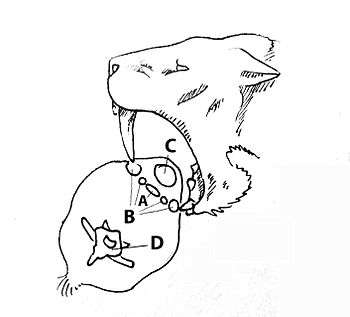
Careful "shearing bite"
Another variation[30] suggests the advanced machairodonts were highly specialized, enough to obtain the specific geometry to puncture the four major blood vessels in the throat of a prey animal in one bite. This hypothesis would include a careful bite to puncture the blood vessels, similar to, but more precise than, the bite-and-compress hypothesis, where the machairodont would retreat and allow the animal to bleed to death very quickly.
Though bloody, this method would take the shortest amount of time to kill the animal out of all the hypotheses. Because of the differences of anatomy between species possibly hunted by machairodonts, the geometry needed to kill a horse, for instance, might not work for a bison. This would require the genus, or even the specific species, to be highly specialized for one type of prey animal. This might offer an explanation for their extinction, for the movement or extinction of that prey species would lead to the death of its specialist predator.
The high specialization seems an extreme and unnecessary version of a bite-and-retreat version of the throat-shear, but the suggestion that machairodont species became more specialized to hunt one prey species is usually considered acceptable so long as the misconception that the machairodont hunted 'only' that species is taken. However, this would not resolve the issue of the messiness and the loud sounds probably associated with this kind of bite. More than one individual would probably have been needed to ensure a completely subdued animal.
"Belly shearing"
In 1985, American paleontologist William Akersten suggested the shearing bite.[51][52] This method of killing is similar to the style of killing seen in hyenas and canines today. A group of machairodonts captured and completely subdued a prey item, holding it still while one from the group bit into the abdominal cavity, pulled back and tore open the body.
For this technique to work, a specific sequence of motions would have be followed. First, the animal must be completely subdued, and the predatory machairodonts must to be social, so that several individuals can hold the prey animal down. The individual preparing to deliver the killing bite would open its mouth at maximum gape, and with its mandible, press up on the skin of the belly. Creating a depression where the lower canines and incisors press into the skin, a slight fold is created in the skin above the lower teeth as the mandible is shoved upward. Next, the upper canines are pressed into the skin and the muscles of the neck are used to depress the head, so instead of pulling the jaw 'up', the skull is pressed 'down' . When the canines pierce the skin, they are lowered until the gape of the mouth is roughly 45°, where the mandible is pulled up in addition to the skull still being depressed. The small flanges on the anterior portion of the mandible of most machairodonts would be used to aid the depression of the skull. When the animal's mouth is closed, it holds a thick flap of skin between its jaws, behind its canines, and the animal uses the muscles of its lower back and forequarters to pull back, tearing the flap clear of the body. This large gash, once opened, leaves intestines uncovered and arteries and veins torn. The bleeding animal would die within minutes, and the shock of repeated bites, tearing innards from the body, could speed up the process.[53]
This method allows social machairodonts to inflict large wounds on prey animals. Massive blood loss would ensue, and though bloody, the social group would be able to fend off almost any animal attracted to the area. The bite would not need to be specific, and could be repeated to hasten the death of the animal, and it is already seen in the killing methods of several extant species, such as the spotted hyena. Canines are not as likely to be broken due to the softer nature of the abdomen when compared to the throat and jerking movements are not as amplified in the abdomen as they are in the neck. The abdominal-tearing hypothesis has generally been regarded as highly plausible. In the La Brea tar pits, occurrences of broken canines in Smilodon are rare, and this less risky method might have contributed to this.[54]
However, a shearing bite may have been problematic for machairodonts for several reasons. Most ungulates are highly sensitive around the belly and hindquarters, and most predators find it much easier to capture and subdue an animal similar to the domestic cow, by manipulating the head and forequarters. By lowering the animal to the ground and placing itself between the pairs of legs, a machairodont would have suffered great risk of being kicked. The power behind such a kick would easily break teeth, a mandible, or a leg, and cripple or kill the cat.
Sociability might have solved this issue by having one individual deliver the killing bite while others held the animal still. Furthermore, the diameter of the abdomen of a large ungulate such as a bison might have been too large, and the skin too taunt, for a machairodont to grasp a flap of skin at all, much less tear it away from the body. A third issue with the shearing bite is that the canines would need to tear a large hole in the belly of the animal to be successful, but might instead simply flay the skin and produce two long slits. This wound may be painful and bleed, but the animal likely would not bleed to death and could still escape and survive, instead of bleeding to death.
In 2004 an experiment used a pair of mechanical aluminum jaws, cast from the CT scans of a Smilodon fatalis from the La Brea tar pits, to simulate several biting techniques possibly used by Smilodon, including the shearing bite, on a fresh domestic cow carcass.[55] The belly of the cow was found to be too large in diameter for the canines to puncture the skin, which were instead deflected off the body, with the mandible blocking their access. However, the model pulled its jaw upward as modern cats bite, while machairodonts most likely did not, instead pressing their skulls down with the aid of their neck muscles. This flaw in the procedure might nullify the results and leave the belly-shearing hypothesis untouched.
Popular culture
The potency of the idea of saber-toothed predators is spurred on by the instinctive fear by humans of large predators and the equality of canines and aggression, another source of fear. The fascination with this extinct group rivaled and exceeded almost all other extinct groups of animals, save for the dinosaurs. The fear and interest in saber-toothed predators, specifically machairodonts, and even more specifically Smilodon as it often is, created numerous allusions to them in popular culture. Their skeletons grace many museums, paintings, and drawings, and statues and sculptures of these animals are numerous.
In 1977, the movie Sinbad and the Eye of the Tiger featured a large machairodont, probably Smilodon, animated in stop-motion, which offers one of the challenges to be overcome by the main character, Sinbad.[56]
In 2001, the BBC produced the miniseries Walking with Beasts, in which one episode follows the life of an imaginary Smilodon group and their social interactions, which were very similar to those of modern lions.[57]
In the 2002 children's film Ice Age (2002 film), Diego, one of the main characters is a Smilodon. He is a member of a pack that includes himself, three other Smilodons, and one Homotherium. Unlike their real-life counterparts, the Homotherium is more robustly built and larger than the Smilodon.[58]
In 2007, the BBC TV series Primeval incorporated a scene in which the main characters must battle a large machairodont (specifically a Smilodon).[59]
In 2008, Warners Bros announced the production of the film 10,000 BC. This film, as the name suggests, takes place rough 12,000 years ago and follows the fictional tale of a hero. Smilodon plays a key role in this film as the savage predator which, according to a prophecy, will refuse to kill the man destined to save them, which plays out with the main character and a greatly oversized Smilodon.[60]
Also in 2008, Prehistoric Predators, a miniseries aired by National Geographic, featured behaviors and interactions between the dire wolf, Smilodon, and the short-faced bear.[61]
Notes and references
- ↑ Paleobiology Database: Machairodontinae Basic info.
- 1 2 3 4 Lars W. van den Hoek Ostende, Michael Morlo, Doris Nagel: Fossils explained 52 Majestic killers: the sabre-toothed cats. Blackwell Publishing Ltd, Geology Today, Vol. 22, No. 4, July–August 2006 online
- ↑ Jordi Augusti: Mammoths, Sabertooths and Hominids 65 Million Years of Mammalian Evolution in Europe, Columbia University Press, 2002. ISBN 0-231-11640-3
- ↑ Lars W. van den Hoek Ostende, Michael Morlo & Doris Nagel (July 2006). "Fossils explained 52 Majestic killers: the sabre-toothed cats". Geology Today. 22 (4): 150–157. doi:10.1111/j.1365-2451.2006.00572.x.
- ↑ Paleobiology Database
- ↑ Turner, Alan (1990). "The evolution of the guild of larger terrestrial carnivores during the Plio-Pleistocene in Africa". Geobios. 23 (3): 349–368. doi:10.1016/0016-6995(90)80006-2.
- ↑ Martin, L. D.; Babiarz, J. P.; Naples, V. L.; Hearst, J. (2000). "Three Ways To Be a Saber-Toothed Cat". Naturwissenschaften. 87 (1): 41–44. doi:10.1007/s001140050007.
- ↑ Turner, Alan (1997). The Big Cats and their fossil relatives. New York: Columbia University Press. p. 60. ISBN 0-231-10228-3.
- ↑ http://link.springer.com/article/10.1007/s10914-014-9266-5
- ↑ Anton, Mauricio (2013). Sabertooth.
- ↑ https://www.flmnh.ufl.edu/florida-vertebrate-fossils/species/rhizosmilodon-fiteae
- ↑ Anton, Mauricio (2013). Sabertooth.
- ↑ Anton, Mauricio (2013). Sabertooth.
- ↑ Anton, Mauricio (2013). Sabertooth.
- ↑ Anton, Mauricio (2013). Sabertooth.
- ↑ http://link.springer.com/article/10.1007/s10914-014-9266-5
- ↑ Anton, Mauricio (2013). Sabertooth.
- 1 2 3 4 Anton, M.; M. J. Salesa; J. Morales; A. Turner (2004). "First known complete skulls of the scimitar-toothed cat Machairodus aphanistus (Felidae, Carnivora) from the Spanish late Miocene site of Batallones-1". Journal of Vertebrate Paleontology. 24 (4): 957–969. doi:10.1671/0272-4634(2004)024[0957:FKCSOT]2.0.CO;2.
- 1 2 3 4 5 Salesa, M.J.; M. Anton; A. Turner; J. Morales (2005). "Aspects of the functional morphology in the cranial and cervical skeleton of the sabre-toothed cat Paramachairodus ogygia (Kaup, 1832) (Felidae, Machairodontinae) from the Late Miocene of Spain: implications for the origins of the machairodont killing bite". Zoological Journal of the Linnean Society. 144 (3): 363–377. doi:10.1111/j.1096-3642.2005.00174.x.
- ↑ Dawson, M.R.; R.K. Stucky; L. Krishtalka; C.C. Black (1986). "Machaeroides simpsoni, new species, oldest known sabertooth credont (Mammalia), of Lost Cabin Eocene". Contributions to Geology, University of Wyoming, Special Paper. 3: 177–182.
- ↑ Salesa, M.J.; M. Anton; A. Turner; L. Alcala; P. Montoya; J. Morales (2010). "Systematic revision of the late Miocene sabre-toothed felid Paramachaedrodus in Spain". Palaeontology. 53 (6): 1369–1391. doi:10.1111/j.1475-4983.2010.01013.x.
- ↑ Turner, A. (1997). The big cats and their fossil relatives: an illustrated guide to their evolution and natural history. New York: Columbia University Press.
- ↑ Van Valkenburgh, B.; F. Hertel (1993). "Tough times at La-Brea – tooth breakage in large carnivores of the Late Pleistocene". Science. 261 (5120): 456–459. doi:10.1126/science.261.5120.456. PMID 17770024.
- ↑ Van Valkenburgh, B. (2009). "Costs of carnivory: tooth fracture in Pleistocene and Recent carnivorans". Biological Journal of the Linnean Society. 96: 68–81. doi:10.1111/j.1095-8312.2008.01108.x.
- 1 2 Salesa, M.J.; M. Anton; A. Turner; J. Morales (2010). "Functional anatomy of the forelimb in Promegantereon ogygia (Felidae, Machairodontinae, Smilodontini) from the Late Miocene of Spain and the origins of the sabre-toothed felid model". Journal of Anatomy. 216 (3): 381–396. doi:10.1111/j.1469-7580.2009.01178.x. PMC 2829396
 . PMID 20039979.
. PMID 20039979. - 1 2 3 4 5 6 7 8 9 Turner, Alan (1997). Big Cats and their Fossil Relatives. Columbia University Press.
- ↑ Christiansen, Per (2008). "Evolution of Skull and Mandible Shape in Cats (Carnivora: Felidae)". PLoS ONE. 3 (7): e2807. Bibcode:2008PLoSO...3.2807C. doi:10.1371/journal.pone.0002807.
- ↑ Laden, Greg. "Greg Laden's Blog: About". Archived from the original on June 13, 2011.
- 1 2 Wroe, Stephen; Lowry, Anton (4 May 2006). "How to Build a Mammanian Super-Predator". Zoology: 1.
- 1 2 Turner, 1997
- 1 2 Bryner, Jeanna. "Saber-Toothed Cat Had Wimpy Bite".
- ↑ "Stable Isotopes in Archaeology".
- ↑ R. H. Tykot. "Stable Isotopes and Diet: You Are What You Eat" (PDF).
- ↑ Antón, M.; García-Perea, R.; Turner, A. (1998). "Reconstructed facial appearance of the sabretoothed felid Smilodon". Zoological Journal of the Linnean Society 124 (4): 369–386, esp. 377-378.
- ↑ Antón, García-Perea, & Turner (1998), 375-377.
- ↑ Abdulla, Sara (28 January 1999). "The smilodon's smile". Nature. doi:10.1038/news990128-5.
- ↑ Antón, García-Perea, & Turner (1998), 375.
- 1 2 Mestel, Rosie (April 1, 1993). "Saber-Toothed Tales". Discover Magazine.
- ↑ "Saber-toothed Cat Sculpture".
- 1 2 Carbone, C.; Maddox, T.; Funston, P. J; Mills, M. G.L; Grether, G. F; Van Valkenburgh, B. (23 February 2009). "Parallels between playbacks and Pleistocene tar seeps suggest sociality in an extinct sabretooth cat, Smilodon". Biology Letters. 5 (1): 81–85. doi:10.1098/rsbl.2008.0526. PMC 2657756
 . PMID 18957359.
. PMID 18957359. - ↑ Metcalfe, Jessica Z. "Late Pleistocene Climate and Proboscidean Paleoecology".
- ↑ "Elephant Kill at the Savute Safari Lodge".
- ↑ Kemp, Leigh. "Elephant Eaters of the Savuti".
- ↑ "Sabertooth Cat, Chinese Machairodus giganteus Skull".
- ↑ Shermis, Stewart (1983). "Healed Massive Pelvic Fracture in a Smilodon from Ranco La Brea, California" (PDF). Paleobios. 1 (3): 12–126.
- ↑ McCall, Sherman; Naples, Virginia; Martin, Larry (2003). "Assessing behavior in extinct animals: was Smilodon social?". Brain Behav. Evol. 61 (3): 159–64. doi:10.1159/000069752. PMID 12697957.
- ↑ Switek, Brian. "Revised Repost: What big teeth you have". ScientificBlogs.
- ↑ "General Kestrel Information" (PDF). kestrelsacrossamerica.org.
- ↑ Andersson, K.; Norman, D.; Werdelin, L. (2011). Soares, Daphne, ed. "Sabretoothed Carnivores and the Killing of Large Prey". PLoS ONE. 6 (10): e24971. doi:10.1371/journal.pone.0024971. PMC 3198467
 . PMID 22039403.
. PMID 22039403. - ↑ McHenry, C. R.; Wroe, S.; Clausen, P. D.; Moreno, K.; Cunningham, E. (2007). "Supermodeled sabercat, predatory behavior in Smilodon fatalis revealed by high-resolution 3D computer simulation". Proceedings of the National Academy of Sciences. 104 (41): 16010–16015. doi:10.1073/pnas.0706086104. PMC 2042153
 . PMID 17911253.
. PMID 17911253. - ↑ Page, Jake. Do Cats Hear with Their Feet?: Where Cats Come From, what We Know about Them.
- ↑ "Saber-toothed cats".
- ↑ "Prehistoric Predators: Sabertooth Part 4".
- ↑ Quammen, David. Monster of God: the man-eating predator in the jungles of history and the mind.
- ↑ Gorder, P. F. "Simulated bite marks [digital simulation]" (PDF).
- ↑ "Sinbad and the Eye of the Tiger".
- ↑ "Smilodon- Clash of the Sabers".
- ↑ http://www.imdb.com/title/tt0268380/trivia?item=tr1889150
- ↑ "Primeval".
- ↑ "10,000 BC".
- ↑ "Smilodon vs. dire wolf vs. actrodus".
- Report on Barnett group's study in Current Biology August 9, 2005: Ross Barnett et al.: "Evolution of the extinct Sabretooths and the American cheetah-like cat" in Current Biology, Vol. 15, R589-R590, August 9, 2005
Further reading
- Van Valkenburgh, B. (2007). "Deja vu: the evolution of feeding morphologies in the Carnivora". Integrative and Comparative Biology. 47 (1): 147–163. doi:10.1093/icb/icm016.. Full analysis of convergent evolution of hypercarnivores
External links
| Wikispecies has information related to: Machairodontinae |
| Wikisource has the text of a 1911 Encyclopædia Britannica article about Machairodontinae. |
Diagrams
- Evolution of feliform saber-tooth skull shape, on Nimravid's Weblog
- Saber-tooth skull diagrams
- Diagrams by Maricio Anton. All graphite drawings belong to Anton, along with several other artists. The second to last drawing depicts the versatility of the general neck bite and include a comparison of Machairodus and Panthera leo in head and face.
Miller's lips
- Illustrations of Miller's lips in phases of aggression and nonaggression. (Be sure to click anywhere on the page as soon as you enter- it is a slideshow and move to the next image in 5 seconds.)
- Biological artist Maricio Anton's depiction of Machairodus without Miller's lips. (this is a foreign site- the image is two thirds of the way down labeled Image: Mauricio Anton)
- Further illustration (Anton) of a lack of Miller's lips with the genus Homotherium
